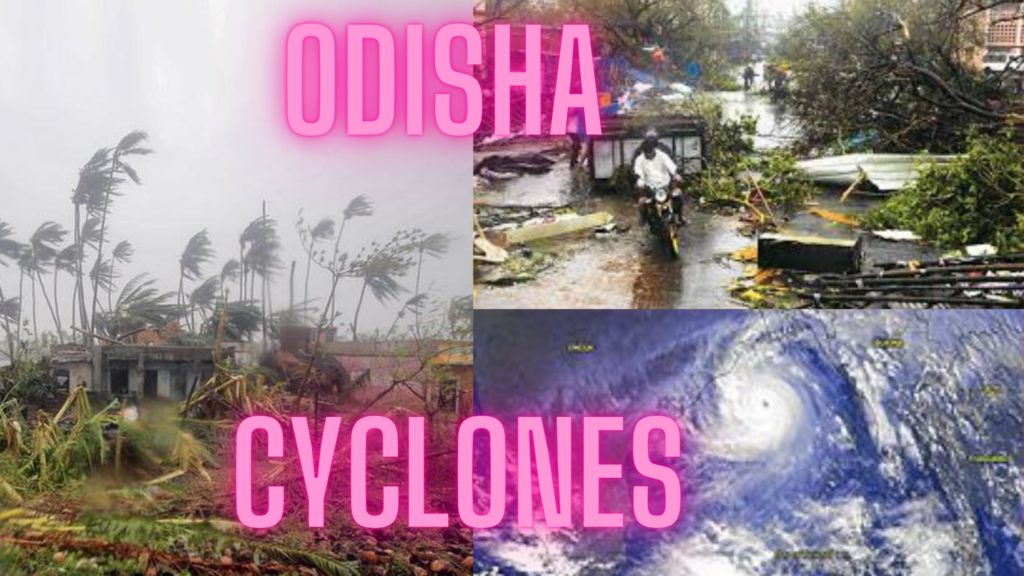
An Overview of Historical Cyclones That Affected Odisha Located on the east coast of India, Odisha has often been hit hardest by tropical storms that originate in the Bay of Bengal. Because of its location, it is susceptible to powerful storms, which frequently cause extensive destruction. Odisha has had many cyclones over the years, and each one has had a significant effect on the state’s population, infrastructure, and economy. Here is a thorough analysis of some of the most notable cyclones to have struck Odisha:
- The Super Cyclone of 1999 -The 1999 Odisha Super Cyclone is remembered as one of the deadliest cyclones to ever strike India. With wind gusts of more than 260 km/h (160 mph), it hit on October 29, 1999, and lasted for more than 30 hours. Millions of people were left homeless and over 10,000 people died as a result of the cyclone’s unparalleled devastation. The super typhoon caused severe flooding, ruined crops, and devastated entire settlements. The Odisha State Disaster Management Authority (OSDMA) was established as a result of it.
- Phailin Cyclone (2013) -On October 12, 2013, Cyclone Phailin, one of the most powerful cyclones to hit land in recent memory, made landfall in Odisha. Phailin caused extensive damage, especially in coastal locations like Ganjam, Puri, and Khordha, with wind gusts of up to 210 km/h. However, compared to the 1999 Super Cyclone, which claimed 45 lives, the death toll was far lower because of better early warning systems and the evacuation of more than a million people. Crops and infrastructure suffered significant damage as a result of the cyclone, with an estimated ₹4,240 crore in economic losses.
- Hudhud Cyclone (2014) -In October 2014, Cyclone Hudhud hit southern Odisha and made landfall in Andhra Pradesh, close to Visakhapatnam. Although not as destructive as Phailin or the Super Cyclone, Hudhud severely damaged infrastructure and agriculture in the southern coastal regions of Odisha due to wind and heavy rainfall.
- Titli Cyclone (2018) -On October 11, 2018, Cyclone Titli made landfall in Andhra Pradesh, close to Palasa, however it had a significant impact on the districts of Ganjam, Gajapati, and Rayagada in Odisha. Titli triggered landslides and flash floods, especially in the interior, with wind speeds of up to 150 km/h. More than 60 people lost their lives as a result of the cyclone, which also seriously damaged farmland and property.
- Cyclone Bulbul (2019)
In November 2019, Odisha saw intense rainfall and severe gusts along its coast, while West Bengal and Bangladesh were the main areas hit by Cyclone Bulbul. Bulbul caused flooding in several areas of Odisha, damaging homes and crops, though its effects were not as bad as those of past cyclones. - CYCLONE FANI-On May 3, 2019, Cyclone Fani, which had wind gusts of 200 km/h, made landfall in Odisha. It was one of the strongest storms in recent memory. Coastal districts including Puri, Khordha, and Cuttack suffered significant damage as a result of Fani. 64 people were killed because more than 1.2 million people were evacuated before the storm hit. Thousands of houses were demolished, and power and telecommunications were badly disrupted, demonstrating the extent of the infrastructure destruction. Significant agricultural losses were also caused by Fani, particularly in the cashew and coconut plantations.
- Cyclone Amphan (2020)
Despite making landfall in West Bengal, Cyclone Amphan also had a major impact in Odisha. Amphan struck on May 20, 2020, bringing with it torrential rains and high winds that caused flooding and devastation in a number of Odisha districts. Numerous homes, farms, and coastal infrastructure were severely damaged, and over 44 lakh people were impacted. Despite escaping the worst of the hurricane, Odisha suffered significant financial losses. - Cyclone Yaas (2021)
On May 26, 2021, Cyclone Yaas made landfall close to Balasore, Odisha, with winds of about 130–140 km/h. Yaas severely damaged crops and infrastructure, particularly in the coastal districts in the north. Before the storm, more than 6 lakh people were evacuated. Although there were not many fatalities, Yaas caused severe flooding and embankment damage that affected vast areas of agricultural land
In conclusion The state’s susceptibility to natural calamities is shown by Odisha’s experience with cyclones. Even though severe storms occur frequently, the state has made great strides in disaster preparedness, lowering damage and mortality through mass evacuations, early warning systems, and robust infrastructure. The state is still investing in long-term plans to lessen the effects of upcoming storms, and the OSDMA has been instrumental in organizing responses to cyclones.
However, with the effects of climate change leading to more frequent and intense cyclones, Odisha’s challenges are far from over. The state must continue to strengthen its resilience to ensure minimal loss of life and economic disruption in the future.
Local people have been actively involved in disaster preparedness efforts by the Odisha government. Villagers receive training in rescue techniques, evacuation protocols, and first aid. When cyclones are imminent, this community-driven strategy guarantees prompt action. In conclusion The proactive approach of Odisha’s cyclone management strategy, which includes early warning systems, prompt evacuations, and resilient infrastructure, has contributed to its success. Odisha has established a standard for disaster management by emphasizing readiness, which has greatly decreased the number of fatalities from storms in recent years.